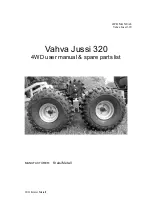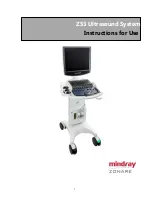
11
Wear your personal protective equipment in
accordance with the hazard category of the
medium to be processed, otherwise there is a risk of:
- splashing of liquids
- projectile parts
- body parts, hair, clothing and jewelry getting caught.
Beware of the risk of:
- flammable materials
- glass breakage as a result of mechanical shaking power.
Reduce the speed if:
- the medium splashes out of the vessel because the speed is
too high
- the instrument is not running smoothly
- the instrument begins to move around because of dynamic forces
- an error occurs.
Do not touch rotating parts during
operation!
•
There may be electrostatic activity between the medium and
the output shaft which could cause a direct danger.
• After an interruption in the power supply or a mechanical interrup
-
tion during a stirring process, the unit does not restart automatically.
•
It is important to note that the surfaces of the motor (cooling
fins) and certain parts of the bearing may get very hot during
operation.
• Never cover the ventilation slots or cooling fins on the motor or
on the instrument.
• Avoid knocking and impacting on the lower end of the shaft and
the chuck gear teeth. Even minor, invisible damage can lead to
imbalance and uneven shaft action.
• Ensure that the stand does not start to move.
•
Imbalance of the output shaft, the chuck and in particular the stir-
ring tools can lead to uncontrolled resonant vibrational behavior
of the instrument and the whole assembly. Glass apparatus and
stirrer containers can be damaged or shattered by this. It can cause
injury to the operator, also can damage the rotating stirring tool. In
this case exchange the stirring tool for one without imbalance or
remedy the cause of the imbalance.
If there is still imbalance, return it to the dealer or the manufac-
turer along with a description of the fault.
• If the instrument is operated too long in overload or if the ambi
-
ent temperature is too high, the instrument switches off per-
manently.
•
The machine must only be opened by trained specialists, even
during repair. The instrument must be unplugged from the power
supply before opening. Live parts inside the instrument may still
be live for some time after unplugging from the power supply.
Covering or parts that are capable of being
removed from the unit without accessory
equipment have to be reattached to the unit for safe operation
in order to prevent, for example, the ingress of fluids, foreign
matter, etc..
If during operation the
battery pack RB 1
(re-
chargeable battery) becomes fully discharged,
the device will continue to run or is shut down depending on the
value settings for exceeding the time and safety speed. If the device
is set so that it continues to run when the battery of the
Wi
reless
Co
ntroller (
WiCo
) is fully discharged, the only means of switching
the station off are the "
safe STOP
" and the off switch!
Please note the following safety instruc-
tions for the battery pack RB 1 (recharge-
able battery):
• Keep the battery pack out of reach of children at all times.
• Store the battery pack in a cool, dry place.
• Never throw the battery pack into a fire. Keep it away from di
-
rect sunlight and temperatures above 60 °C. High temperatures
will damage the battery pack and render it unusable. Tempera-
tures above 100 °C may cause it to explode.
• Never throw the battery pack into water or expose it to mois
-
ture. Water may lead to a short-circuit, causing the battery pack
to explode.
•
Do not deform or crush the battery pack or damage it in any
other way. This can cause battery fluid to leak and/or the bat
-
tery pack to explode.
• When not in use, keep battery packs away from paperclips,
coins, keys, nails, screws or other small metal objects which
could cause the contacts to be bridged. Short-circuiting may
result in an explosion.
• Explosion of a battery pack may release battery fluid and cause
a fire.
• The lithium polymer battery pack must only be used and charged
in
IKA
®
products designed for use with this battery pack.
• When the battery pack is inserted it should slide in easily and
without resistance. Do not force it.
• If the battery pack is removed for an extended period of time,
store it in a sealed plastic bag to prevent short-circuiting due to
moisture or contact with metal components.
• The operating temperature range of the battery pack is from
0 °C to +45 °C. Note that the battery pack capacity will be re-
duced at temperatures below 20 °C.
•
Only the rechargeable battery types recommended in the technical
data may be used in the device!
Do not charge batteries that have leaked or that are discol-
ored, deformed or damaged in any other way.
Disposal instructions:
• When disposing of the
IKA
®
battery pack, please tape over the
contacts with adhesive tape to prevent short-circuiting due to
moisture or contact with metal components. Short-circuiting may
result in an explosion.
• Do not throw used battery packs into your household waste. Dis
-
pose of them properly in accordance with statutory regulations.
End users are obliged by law to return all used dispos-
able and rechargeable batteries. Throwing them into the
household waste is prohibited. Disposable/rechargeable batter-
ies containing harmful substances are marked with this symbol
to indicate that they may not be disposed of as household waste.
•
You can return used disposable and rechargeable batteries free
of charge to your local authority collection site or to any battery
retailer. In doing so you will be complying with statutory regula-
tions and helping to protect the environment.
• Batteries must be disposed of in accordance with local and na
-
tional regulations.
DANGER
DANGER
DANGER
WARNING
DANGER
DANGER
DANGER












































